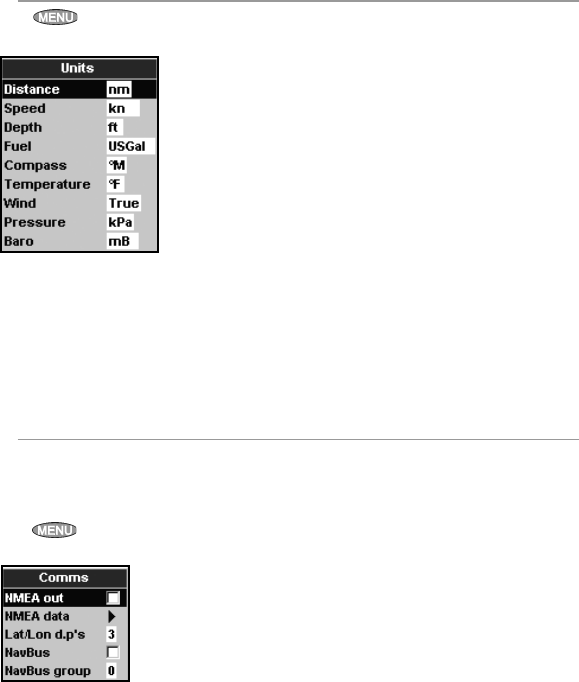
Northstar Explorer 538i/538 Installation and Operation Manual
47
14-8 Setup > Units
Press one or more times until the Setup
menu is displayed, then select Units:
The default units are shown above.
Distance
nm (nautical miles), mi (miles) or km (kilometres)
Speed
kn (knots), mph (miles per hour) or kph
(kilometres per hour)
Depth
ft (feet), m (metres) or fa (fathoms)
Fuel
Litres, USGal (US gallons) or ImpGal (Imperial
Gallons)
Compass
°T (True north) or °M (Magnetic north)
Temperature
°F (Fahrenheit) or °C (Celsius)
Wind (optional)
Requires a wind instrument: True or App
(Apparent)
Note: that the units for wind speed are the speed
units.
Pressure
Requires SmartCraft: kPa or psi
Baro (Barometric pressure)
Requires a Northstar VHF receiver connected by
NavBus: InHg or mB.
Use this feature when the Explorer 538/538i
is connected to other Northstar instruments
through NavBus or any compatible NMEA
instrument.
Press once or more until the Setup
menu is displayed, then select Comms:
NMEA out
NMEA is generally used with third party
instruments (see section 15-9). Select this to
transmit NMEA sentences, for example to an
autopilot.
NMEA data
Use this to specify which NMEA sentences will be
transmitted (see section 15-9 and Appendix A).
Lat/lon dps
Select the number of decimal points used
for latitude and longitude transmitted in
NMEA sentences.
NavBus
NavBus is the preferred method for connecting
the Explorer 538/538i to other Northstar
instruments. Select this if the instruments are
connected using NavBus.
NavBus Group
Use this when a group of Northstar instruments
are connected together using NavBus, to specify
a group of instruments for backlighting, if
required. Then, if the backlight setting on one
instrument in the group is adjusted, the other
instruments change automatically. Otherwise,
select 0. See section 15-8.
14-9 Setup > Comms


















